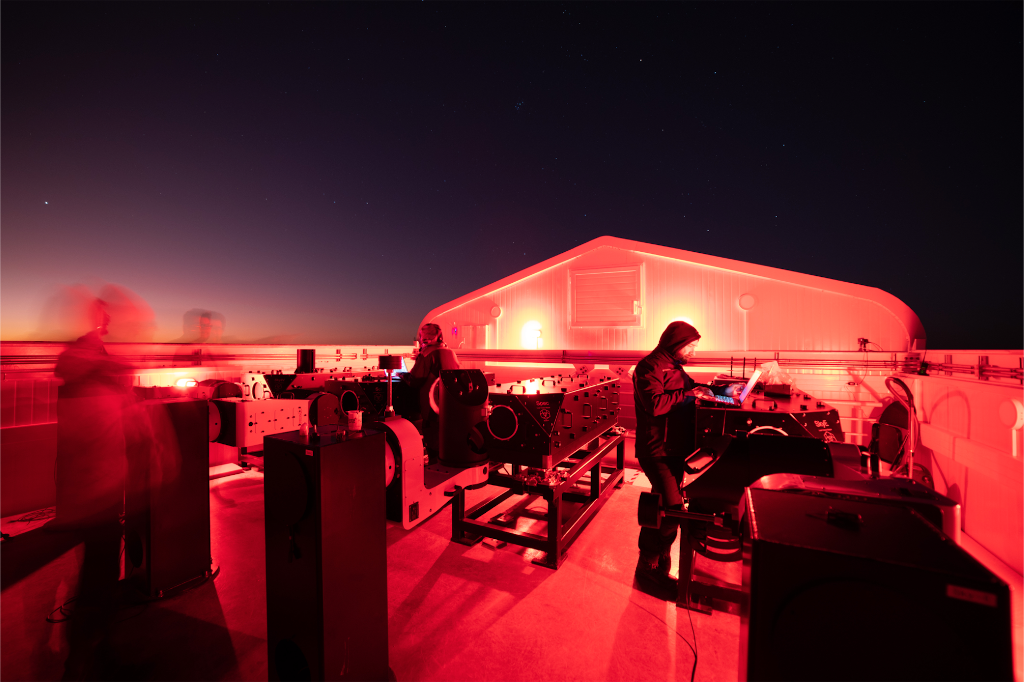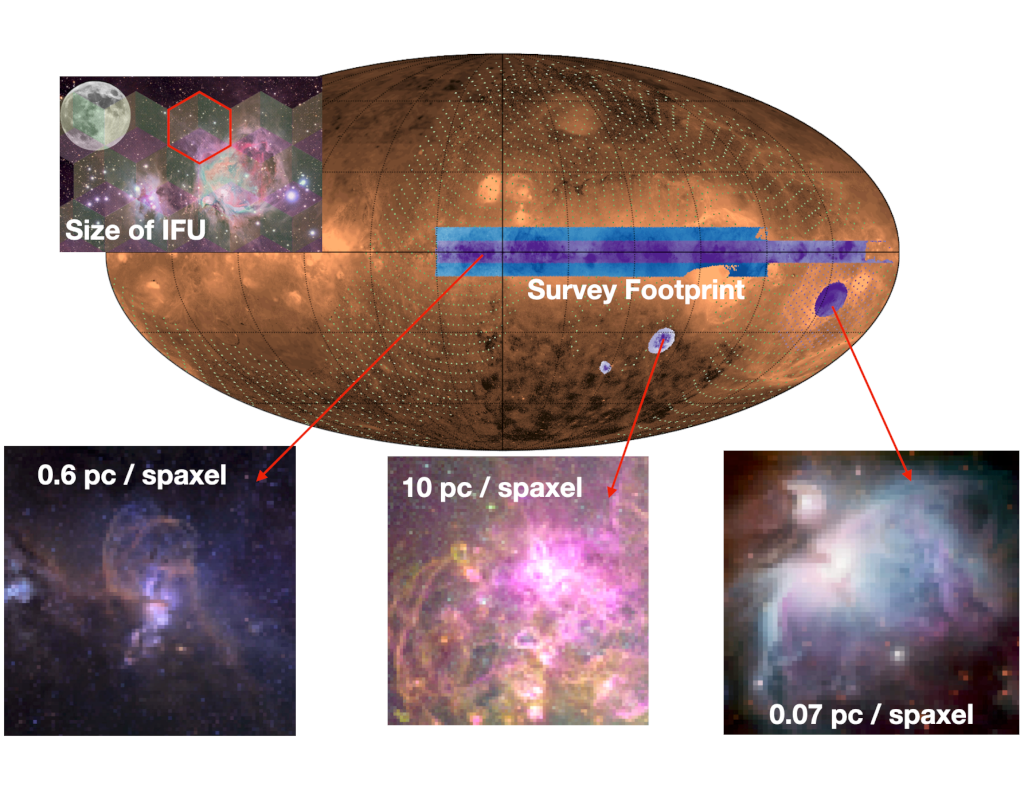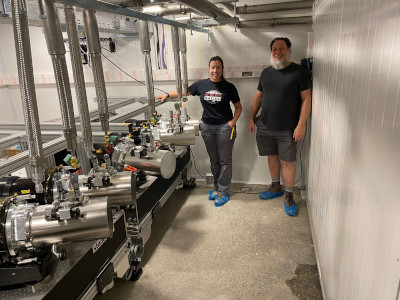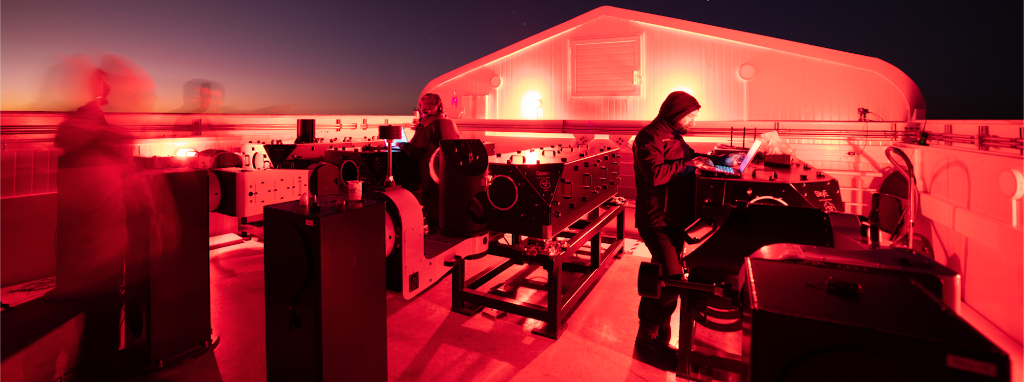The newest mapmaking effort of the long-running Sloan Digital Sky Survey has begun.

Image Credit: Maximilian Häberle (Max-Planck-Institute for Astronomy) and the SDSS collaboration
The Local Volume Mapper (LVM) Instrument has seen first science light. LVM is one of the three mappers that make up the fifth phase of the SDSS’s ambitious all-sky, multi-epoch spectroscopic survey. This new instrument will create a spectroscopic map of the Milky Way and other nearby galaxies.
“This is not just a new instrument – it is an entirely new observatory that we created as part of SDSS,” said Juna Kollmeier, Director of the fifth and current phase of the SDSS. “Integral field spectroscopy (IFS) is part of the rugged frontier of 21st century astronomical observations. I am awed and humbled by the achievements of this talented and dedicated international team!”

Image Credit: Tom Herbst (Max-Planck-Institute for Astronomy) and the SDSS collaboration
LVM is the first spectroscopic survey to cover such a large area of the sky in a homogenous way. What makes it new is its approach to mapping the sky. While previous surveys have focused on individual stars, quasars, and galaxies, LVM will observe the “interstellar medium” (ISM) – the gas and dust that fills in the space between stars. The survey will examine this gas and how it interacts with the stars not just in the Milky Way, but also in our galactic companions the Magellanic Clouds, and several other nearby galaxies in the Local Group.
“We have always looked at individual objects in the Milky Way,” said Niv Drory of the University of Texas at Austin and program head of the LVM project. “Now, we look at everything. No gaps, no selection effects – we observe the whole sky.”

Image Credit: Nick Konidaris (Carnegie Observatories)
The first step toward completing this ambitious all-sky mapping project has begun, with the first science observations of the new Local Volume Mapper Instrument (LVM-I), located at Las Campanas Observatory high in the Atacama Desert of northern Chile. The innovative instrument and telescope design will allow astronomers to use the Milky Way as an astrophysical laboratory to understand how stars form and inject energy, momentum, and chemical elements into their local surroundings. This energy cycle is essential for understanding the physics of galaxy formation.
LVM-I consists of four custom-built telescopes. One telescope performs science observations, while the other three are devoted to real-time calibration observations. A massive fiber bundle, consisting of 2,000 optical fibers, carries the visible light from the telescopes to three spectrographs where the light is separated into different frequencies and analyzed.
The LVM telescopes work like a fly’s eye, in which thousands of individual small lenses separate the light from patches of sky to collect “spectra”, which are measurements of the amount of light that the gas and stars emit at different frequencies. Researchers turn these measurements into a graph that they can read to decode information about the source. This fly’s eye approach allows LVM to take spectra of thousands of neighboring patches over an entire area of the sky at once.
“LVM is the first application of this technique to the entire Milky Way, and is the first step towards a spectroscopic survey of the entire sky,” said Evelyn Johnston, the Survey Operations Scientist for LVM, of University of Diego Portales in Santiago, Chile. “We will be able to resolve star forming regions less than one light-year across, giving us unprecedented detail of these important structures.”
Contacts
Juna Kollmeier
Director, SDSS-V
Canadian Institute for Theoretical Astrophysics (CITA) / University of Toronto
Carnegie Institution for Science
+1 (626) 304-0220
jak@cita.utoronto.ca
jak@carnegiescience.edu
Niv Drory
University of Texas
+1 (512) 471-6197
drory@astro.utexas.edu
Evelyn Johnston
Universidad Diego Portales
evelyn.johnston@mail.udp.cl
Kathryn Kreckel
LVM Survey Scientist
Heidelberg University
+49 (6221) 54-1859
kathryn.kreckel at uni-heidelberg.de
Keith Hawkins
Scientific Spokesperson, SDSS-V
University of Texas
+1 (512) 471-1309
keithhawkins@utexas.edu
“This comprehensive view of these nearby systems is only possible with a unified survey program such as SDSS,” said Kathryn Kreckel of Heidelberg University, the Survey Scientist for Local Volume Mapper.
Now that the facility has been built, and science commissioning has begun, the next step is to begin full science operations. Observations will continue until 2027, covering the Milky Way and several other Local Group galaxies. The result will be a dense spectral map that can be compared to our current theories of galaxy formation and evolution to test how energy and chemicals are cycled through the interstellar medium through stars. This process of star formation and feedback is critical to understanding galaxies across all cosmic epochs. The local volume mapper will provide an essential local laboratory to unravel this process.
The innovative instrument and telescope design will allow astronomers to use the Milky Way as an astrophysical laboratory to understand how stars form and feedback into their local surroundings. This energy cycle is essential for understanding the physics of galaxy formation.
LVM-I consists of four custom-built telescopes. One telescope performs science observations, while the other three are devoted to real-time calibration observations of the sky and standard stars. A massive fiber bundle, consisting of 2,000 fibers, carries fibers from the telescopes to the spectrographs, where the light is dispersed and analyzed.
“LVM is the first application of this technique to the entire Milky Way, and is the first step towards a spectroscopic survey of the entire sky,” said Evelyn Johnston of University of Diego Portales in Santiago, Chile. “We will be able to resolve star forming regions less than one light-year across, giving us unprecedented detail of these important structures.”
“This comprehensive view of these nearby systems is only possible with a unified survey program such as SDSS,” said Kathryn Kreckel of Heidelberg University, the Survey Scientist for Local Volume Mapper.
Now that the facility has been built, and science commissioning has begun, the next step is to begin full science operations. Observations will continue until 2027, covering the Milky Way and several other Local Group galaxies. The result will be a dense spectral map that can be compared to our current theories of galaxy formation and evolution to test how energy and chemicals are cycled through the interstellar medium through stars. This process of star formation and feedback is critical to understanding galaxies across all cosmic epochs. The local volume mapper will provide an essential local laboratory to unravel this process.
Local Volume Mapper Leadership Team
- LVM Program Head: Niv Drory
- LVM Instrument Lead: Nick Konidaris
- LVM Project Manager: Stefanie Wachter
- LVM Telescope Scientist: Tom Herbst
- LVM Survey Scientists: Guillermo Blanc, Kathryn Kreckel
- LVM Software Development Team: José Sanchéz-Gallego, Soojong Pak, Florian Briegel
- Nebular Diagnostics & Chemical Abundances Working Group Chairs: José Eduardo Méndez Delgado, Nimisha Kumari
- Star Formation & Feedback Working Group Chairs: Tony Wong, Maren Cosens
- Stellar Populations Working Group Chairs: Bruno Dias, Sebastian F. Sanchez
- LVM Pipeline Development: Alfredo J Mejía-Narváez, Hector Javier Ibarra-Medel, Sebastian F. Sanchez, Amy M Jones, Jorge K. Barrera-Ballesteros
- LVM Operations, QA, Data Releases: Evelyn Johnston, Dmitry Bizyaev, Dhanesh Krishnarao
About the SDSS
Funding for the Sloan Digital Sky Survey V has been provided by the Alfred P. Sloan Foundation, the Heising-Simons Foundation, the National Science Foundation, and the Participating Institutions. SDSS acknowledges support and resources from the Center for High-Performance Computing at the University of Utah. The SDSS web site is www.sdss.org.
SDSS is managed by the Astrophysical Research Consortium for the Participating Institutions of the SDSS Collaboration, including the Carnegie Institution for Science, Chilean National Time Allocation Committee (CNTAC) ratified researchers, the Gotham Participation Group, Harvard University, Heidelberg University, The Johns Hopkins University, L’Ecole polytechnique fédérale de Lausanne (EPFL), Leibniz-Institut für Astrophysik Potsdam (AIP), Max-Planck-Institut für Astronomie (MPIA Heidelberg), Max-Planck-Institut für Extraterrestrische Physik (MPE), Nanjing University, National Astronomical Observatories of China (NAOC), New Mexico State University, The Ohio State University, Pennsylvania State University, Smithsonian Astrophysical Observatory, Space Telescope Science Institute (STScI), the Stellar Astrophysics Participation Group, Universidad Nacional Autónoma de México, University of Arizona, University of Colorado Boulder, University of Illinois at Urbana-Champaign, University of Toronto, University of Utah, University of Virginia, and Yale University.

